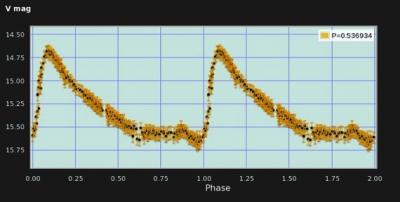
This is an example of what users see when they type in the celestial coordinate of an object to view a time-series light curve or download a computer-readable file of all observations in the database. This image shows the light curve of a variable star whose brightness changes rapidly in only 12 hours.
The University of Arizona's Catalina Sky Survey keeps a watchful eye on asteroids that might cross the Earth's path. A byproduct of that effort is the largest database compiling the brightnesses of 200 million objects in the universe, including supernovae and stars torn up by super-massive black holes.
The night sky is filled with objects such as asteroids that dash across the sky and others – such as exploding stars and variable stars – that flash, dim, and brighten. Studying such phenomena can help astronomers better understand the evolution of stars, massive black holes in the centers of galaxies, and the structure of the Milky Way.
These types of objects also were essential for the recent discovery of dark energy – the mysterious energy that dominates the expansion of the universe – that earned last year's Nobel Prize.
Using images obtained by the UA's asteroid-hunting Catalina Sky Survey, the Catalina Real-Time Transient Survey, or CRTS, lets CalTech astronomers systematically scan the heavens for these dynamic objects, resulting in an unprecedented data set that will allow scientists worldwide to pursue new research.
"Exploring variable objects and transient phenomena like stellar explosions is one of the most vibrant and growing research areas in astrophysics," said S. George Djorgovski, professor of astronomy at Caltech and principal investigator on the CRTS. "In many cases, this yields unique information needed to understand these objects."
The new data set is based on observations taken with the 0.7-meter telescope on Mt. Bigelow in Arizona. The observations were part of the Catalina Sky Survey, a search for Near-Earth Objects, or NEOs – asteroids that may pose a threat to Earth – conducted by astronomers at the UA.
By repeatedly taking pictures of large swaths of the sky and comparing these images to previous ones, the CRTS is able to monitor the brightness of about half-billion objects, allowing it to search for those that dramatically brighten or dim. In this way, the CRTS team identified tens of thousands of variables, maximizing the science that can be gleaned from the original data.
The new data set contains the so-called brightness histories of a total of 200 million stars and other objects, incorporating more than 20 billion independent measurements.
"This set of objects is an order of magnitude larger than the largest previously available data sets of their kind," said Andrew Drake, a staff scientist at Caltech and lead author on a poster presented at the meeting of the American Astronomical Society in Austin on Jan. 12.
"It will enable many interesting studies by the entire astronomical community."
One of the unique features of the survey, Drake said, is that it emphasizes an open-data philosophy. "We discover transient events and publish them electronically in real time, so that anyone can follow them and make additional discoveries."
"It is a good example of scientific-data sharing and reuse," Djorgovski added. "We hope to set an example of how data-intensive science should be done in the 21st century."
The data set includes more than 1,000 exploding stars called supernovae, including many unusual and novel types, as well as hundreds of so-called cataclysmic variables, pairs of stars in which one spills matter onto another, called a white dwarf; tens of thousands of other variable stars; and dwarf novae, which are binary stars that dramatically change in brightness.
"We take hundreds of images every night from each of our telescopes as we search for hazardous asteroids," said Edward Beshore, principal investigator of the UA's asteroid-hunting CSS. "As far back as 2005, we were asking if these data could be useful to the community of astronomers. We are delighted that we could forge this partnership. In my estimation, it has been a great success and is a superb example of finding ways to get greater value from taxpayers' investments in basic science."
The team said it soon plans to release additional data taken with a 1.5-meter telescope
See the website for more details: http://www.eurekalert.org/pub_releases/2012-01/uoa-kae011312.php (SY)
